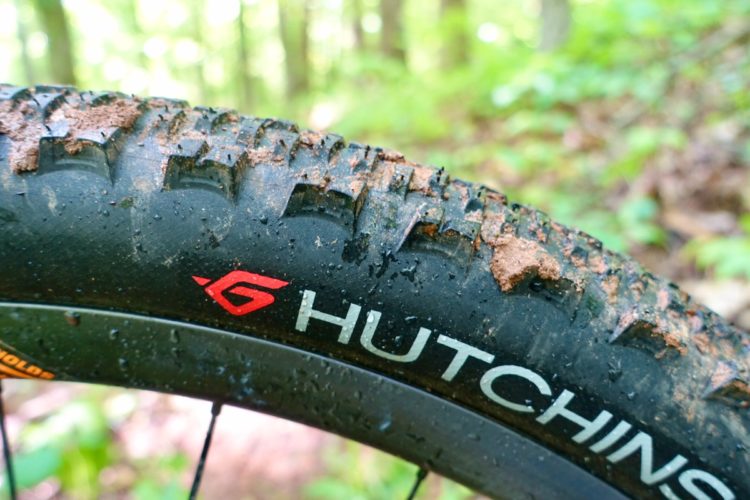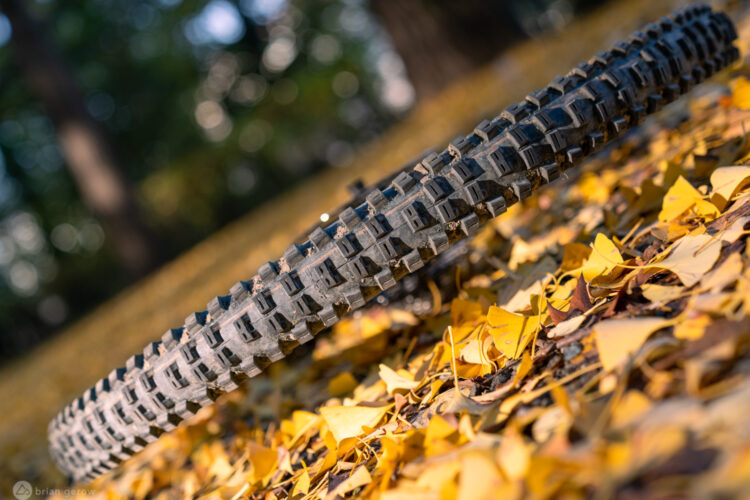
“Two gravity tires diverge in a yellow wood, and I took the one best suited to the terrain.” Is that how it goes, Frost? Maybe choosing the incorrect tire for a given terrain would make a closer rendition of The Road Not Taken.
Poetics aside, this summer I had a chance to test a set of fantastic gravity tires, the Hutchinson Toro and Griffus, side by side. Both tread patterns are available with a variety of casings for different uses, and I rode a pair of each in the Hardskin casing with their Gravity RR tread compound. These are the somewhat narrower option, with the toughest casing and softest tread-rubber. In short, these are precisely the Hutchinson tires I would race enduro on.
With both pairs mounted on 30mm rims, the 29×2.35″ Hutchinson Toro tire and 29×2.4″ Griffus measured identically at 61mm (2.4″). The mid-weight, roughly 1000g tires held up well throughout my test rides at home and in Liguria, and I have yet to puncture the Hardskin shell. The gravity casing provides ample support in corners and hard compressions and doesn’t wander or squirm like a thinner tire. The bead snaps into place easily with a floor-pump, and the casings have been holding air admirably in my chilly basement cantina.

First, the Hutchinson Toro Gravity Tire
Let’s launch in with the Hutchinson Toro, since it came first in the model lineup. Mountain bike tires can grip mechanically via the bite of their tread or chemically via the chemical properties of the rubber compound its self. The former is effective at maintaining traction on loose soils and in mud, while the latter shines on hardpack tracks and stoney segments. Fortunately, most gravity tires combine the two for max-grip all day.
While each of these tire sets use the same rubber compound, the mechanical teeth of the Hutchinson Toro are certainly sharper and further apart than those on the Griffus. The square blocks are spaced to provide sticky grip with a predictable transition between the cornering knobs and center knobs, and they do just that.
The Hutchinson Toro gravity tire hooks up well in loose soil, and sheds mud as well as some of the best all-season tires. The knobs are shorter than a true “mud spike”and they get the grip so long as the dirt isn’t absolute peanut butter.

The simpler, alternating tread pattern on the Hutchinson Toro has been around for quite some time. I recall an early narrower iteration that was one of the first tubeless cyclocross tires, and a refined Toro CX model remains today. For enduro racing and hard gravity riding, the Hutchinson Toro is a fantastic tire in loose and wet conditions. While it doesn’t roll nearly as fast as the Griffus, it holds onto the trail impressively, maintaining the traction needed to ride faster.
- Price: starting at €50/$60
- Available at Wiggle

Hutchinson Griffus Race Tire
The Hutchinson Griffus tire, on the other hand, was designed to maintain as much of that grip as possible, while sacrificing as little traction as possible. The inner and outer rows of knobs alternate slightly to provide grip at almost every angle, and the inside set is ramped to make the tire roll faster on hard-packed trails.
Several Hutchinson-sponsored riders asked for a faster racing tire, and the Griffus tire was the brand’s response. With slightly lower-profile knobs that the Hutchinson Toro, it still hooks up well in most trail conditions and feels fast on dry summer singletrack.
Despite the large space between the inner and outer knobs, the Hutchinson Griffus provides a smooth and predictable transition that won’t throw any surprises in the mix when you’re laser-focused on where to put them next. They also break loose predictably when you apply the brakes to course-correct, and the soft rubber recommits as quickly as the lion’s share of the competition.

I have tested several soft gravity tires that were faster than these. Hutchinson seems to have struck a comfortable balance with their tread compound to land on a tire that provides fantastic traction without being so soft that the knobs rip off or the center tread shows significant wear after a few descents. You could say the Hutchinson Griffus are a race tire, but not a race-day-only tire. Hutchinson keeps those for their elite athletes who are always testing something new.

The casing curvature of the Hutchinson tires is similar to that of a Maxxis DHR. It’s neither too square nor too round, but neutral. This shape makes the Hutchinson Toro and Griffus feel good on almost any surface, apart from off-camber tracks. They will hold to an out-sloped camber, but if that’s what you ride most often there are tires with more square profiles that will work better.


Any enduro racer armed with both of these Hutchinson mtb tires is set up for a fast and fun time. Depending on the weather and soil conditions, one of these tires will be right for the job.




















0 Comments